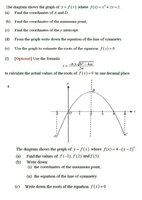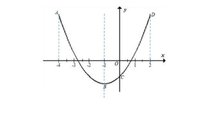Quadratic fucntions
- Thread starter Fresssh
- Start date
Dr.Peterson
Elite Member
- Joined
- Nov 12, 2017
- Messages
- 16,821
We really need to see what you do know how to do, in order to be able to start. The first few questions are surely not that hard.Can someone assist me with this? I have no idea how to do it
For points A and D, you just need to plug in x = -4 and x = 2.
For the minimum point, you can do the same, since they have shown you where it is! There are other ways (one of which is based on your answer to part (a)), but why not use what they give you?
Please show what you can do on those parts, and anything else you can do, and then we can continue from there. I don't want to concede that you are entirely helpless and don't belong in the class you are presumably in.
Well this is a complete new topic to me. We're supposed to use the text book to answer the questions but I do have a learning disability when it comes to numbers which means I need in person teaching or just with a person will be better but when I've learned something I don't forget it
To find the coordinate of the minimum point, look for the value that divides the graph into two equal halves.This is the graph for the first set of questions
In this case, it is [MATH]x = -1[/MATH]
Then, plug this value into the equation to get the value of [MATH]y[/MATH]
[MATH]y = x^2 + 2x - 2[/MATH]
When we plug [MATH]x = -1[/MATH], we get
[MATH]y = (-1)^2 + 2(-1) - 2 = -3[/MATH]
So, the coordinate of the minimum point is [MATH](-1,-3)[/MATH]
Dr.Peterson
Elite Member
- Joined
- Nov 12, 2017
- Messages
- 16,821
I told you what to do for part (a); have you tried it? Evaluating f(-4) and f(2) should not be entirely new to you. And nasi112 has now demonstrated how to find f(-1), that is, to "plug -1" into the equation you were given.Well this is a complete new topic to me. We're supposed to use the text book to answer the questions but I do have a learning disability when it comes to numbers which means I need in person teaching or just with a person will be better but when I've learned something I don't forget it
Remember that new topics are typically introduced using things you already know, so you should expect to be able to answer some questions. The only way to find out how much you understand of what you were taught (or what the book teaches) is to try it. Seriously: You are not entirely helpless. You can do it if you try. And the parts you don't do right, we'll help you with.
I did try some of them. For A I was able to get (-4,6) and for D (2,6). For question c) I'm not 100% sure I did the right thing but I used 0 since x is 0 on the y axis. Question d I'm a bit lost as to how to start it.
For 4a) I was able to get-5, 4 & -5. The maximum point I got as 4 using 2 in 4 - (x-2)²
For 4a) I was able to get-5, 4 & -5. The maximum point I got as 4 using 2 in 4 - (x-2)²
Dr.Peterson
Elite Member
- Joined
- Nov 12, 2017
- Messages
- 16,821
I did try some of them. For A I was able to get (-4,6) and for D (2,6). For question c) I'm not 100% sure I did the right thing but I used 0 since x is 0 on the y axis. Question d I'm a bit lost as to how to start it.
For 4a) I was able to get-5, 4 & -5. The maximum point I got as 4 using 2 in 4 - (x-2)²
For part (c), yes, the y-intercept is f(0); what did you get?
For part (d), the vertical line through point B is the axis of symmetry; you can see how the curve looks like each side is a reflection of the other. What is the equation of that line?
For part (e), they just want you to roughly estimate the locations of the x-intercepts (where the curve crosses the x-axis).
For 4(a), yes, you have the correct values; and for 4(b), the maximum point is (2, 4). The line of symmetry is, again, the vertical line through that. What is its equation?
And for 4(c), they are again asking for the x-intercepts, which you can read off easily -- and then check in the equation.


